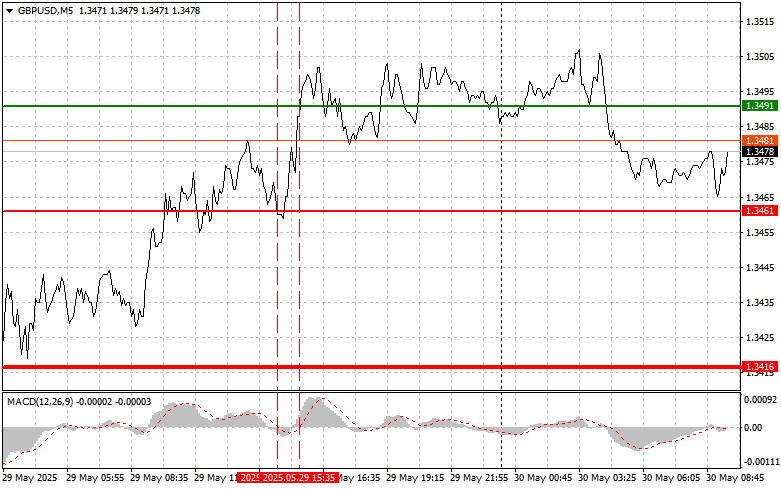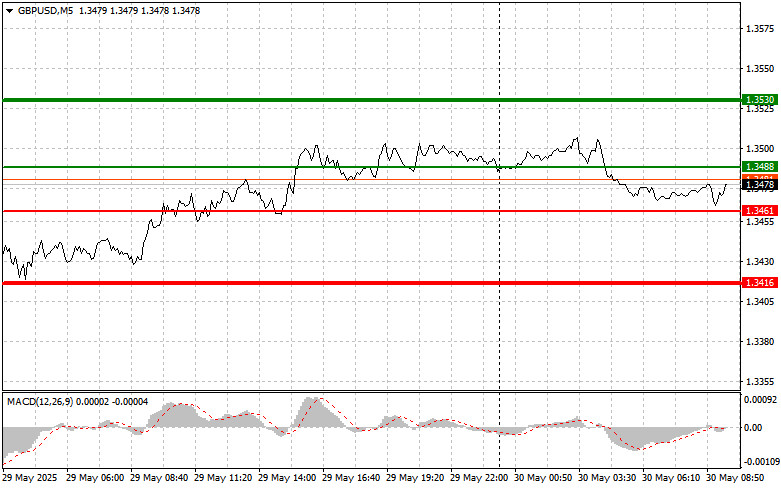Analysis of Trades and Trading Tips for the British Pound
The price test at 1.3461 in the second half of the day coincided with the moment when the MACD indicator had already moved significantly downward from the zero line, which limited the pair's downside potential. For this reason, I did not sell the pound. A similar situation occurred on the buying side at the 1.3491 level.
Yesterday's decision by the U.S. Supreme Court came as an unexpected and ambiguous signal for global markets. The reinstatement of trade tariffs, even temporarily, immediately triggered a chain reaction. Fearing an escalation of the trade war, investors began to reassess their portfolios, leading to capital outflows from American assets and, consequently, a decline in the dollar's value. This move casts doubt on the independence of the U.S. Court of International Trade and creates a precedent for possible executive branch interference in judicial processes. The legal battles surrounding trade tariffs will undoubtedly continue, and the outcome of this confrontation will have far-reaching consequences for the U.S. and global economies.
Given that there are no significant data expected from the UK today, and considering that today is the last trading day of May, it is unlikely that monthly highs will be updated or that there will be a sharp rise in the pound. Instead, it would be more reasonable to expect some profit-taking from previously opened long positions, which could trigger a slight downward correction. However, the fundamental background for the British pound remains relatively favorable. Inflation in the UK is declining, which positively affects businesses and households, allowing the Bank of England to adopt a more dovish stance.
For intraday strategy, I will focus primarily on Scenarios #1 and #2.
Buy Scenario
Scenario #1: Today, I plan to buy the pound at the entry point around 1.3488 (green line on the chart), targeting a rise to 1.3530 (thicker green line on the chart). Around 1.3530, I plan to exit the buys and open sell positions in the opposite direction (aiming for a 30–35 pip move from the entry point). A strong rally in the pound is unlikely today. Important! Before buying, ensure the MACD indicator is above the zero line and is just starting its upward movement.
Scenario #2: I also plan to buy the pound today if there are two consecutive tests of the 1.3461 level when the MACD indicator is in the oversold zone. This would limit the pair's downside potential and lead to a market reversal upward. Growth can be expected toward the opposing levels of 1.3488 and 1.3530.
Sell Scenario
Scenario #1: I plan to sell the pound after breaking below 1.3461 (red line on the chart), which should lead to a quick decline in the pair. The key target for sellers will be the 1.3416 level, where I plan to exit the sales and immediately open buys in the opposite direction (aiming for a 20–25 pip move from the level). Selling the pound can be considered after an unsuccessful attempt to break above the daily high. Important! Before selling, ensure the MACD indicator is below the zero line and just starting its downward movement.
Scenario #2: I also plan to sell the pound today in the case of two consecutive tests of the 1.3488 level when the MACD indicator is in the overbought zone. This would limit the pair's upside potential and lead to a market reversal downward. A decline can be expected toward the opposing levels of 1.3461 and 1.3416.
What's on the Chart:
- The thin green line represents the entry price where the trading instrument can be bought.
- The thick green line indicates the expected price level where a Take Profit order can be placed, or profits can be manually secured, as further price growth above this level is unlikely.
- The thin red line represents the entry price where the trading instrument can be sold.
- The thick red line indicates the expected price level where a Take Profit order can be placed, or profits can be manually secured, as further price decline below this level is unlikely.
- The MACD indicator should be used to assess overbought and oversold zones when entering the market.
Important Notes:
- Beginner Forex traders should exercise extreme caution when making market entry decisions. It is advisable to stay out of the market before the release of important fundamental reports to avoid exposure to sharp price fluctuations. If you choose to trade during news releases, always use stop-loss orders to minimize potential losses. Trading without stop-loss orders can quickly wipe out your entire deposit, especially if you neglect money management principles and trade with high volumes.
- Remember, successful trading requires a well-defined trading plan, similar to the one outlined above. Making impulsive trading decisions based on the current market situation is a losing strategy for intraday traders.














